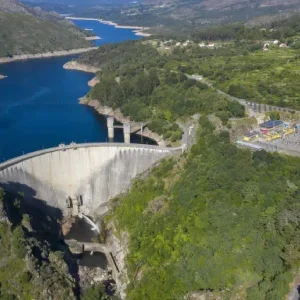WITH 400 000 visitors per year, the La Rance tidal power station in France is the country’s most visited industrial site. It also acts as a road bridge crossed each day by 25 000 vehicles and a lock providing access for 17 000 boats each year.
France is still the only country in the world to have built a tidal power station on an industrial scale. There are only three other smaller plants in operation in the world (Kislaïa Guba in Russia, Jiangxia in China and Annapolis in Canada). Other projects are now being studied in Korea, the UK and India.
The La Rance tidal power station was opened in 1966 by General de Gaulle after studies lasting 25 years. Indeed, the site had to meet two important conditions: exceptional tides and a wide bay which could be easily closed. With 24 bulb-type units, La Rance has a total installed power of 240MVA. These 24 units are grouped into six ‘operating groups’, each one of which consists of four bulb-type units that operate simultaneously.
The groups have an operating mode specific to the La Rance station, and have been adapted to the problems of managing the quantity of water available during different tidal phases. These adaptions include being:
• Reversible – capable of rotating in either direction, depending on the water flow.
• Electrically reversible – to be capable of operating either as generators (turbining) or motors (pumping).
• Capable of serving as orifices for water passage, in either direction.
The essential point about the operation of the La Rance bulb-type units therefore resides in the reversibility of their rotation direction, either when used as a generator or motor. In fact, the La Rance bulb-type units operate about two-thirds of the time in an estuary sea water direction.
Electricity needs
Today, the La Rance station produces 3.5 per cent of Brittany’s electricity needs but supplies 90 per cent of the energy produced in the region. In 1996, on its thirtieth anniversary, the station (which had been operational for 160 000 hours) began a renovation programme which will last until 2004.
Sarelem (Société des Ateliers de Réparations Electriques et Mécaniques) has been selected by the French electricity board (edf) to rebuild seven stators and manufacture two new stators, all of them to be interchangeable. The rebuilding of generator B5’s stator has now been completed. Delivered to EDF early last year, it required in total nearly 5000 man hours by Sarelem personnel. Due to the impressive dimensions (4.70m in diameter, weighing 45 tons), the stator was transported by a special convoy to the port at La Rance.
The two other new spare parts units (N1 and N2) were also completed according to the schedule. The remaining stators will be worked on progressively until 2004.
Rebuilding techniques
To palliate the serious problems encountered during the operation of bulb-type units, Sarelem has reviewed the fastening design. Notable problems included the deterioration of the fastening of the magnetic circuit within the stator housing, which caused friction between the rotor and the stator. The resistance of the stators over time for this specific problem is now theoretically infinite, and the new Sarelem stator winding insulation method makes it possible to extend the insulation’s service life by about 15 years.
Sarelem has introduced a new material that exceeds, in mechanical strength, all of the conventional steel components of existing generators. This is an alloy, which is used in aircraft structures. Due to its excellent mechanical characteristics and low density, the non-magnetic alloy also makes it possible to limit the losses in the metallic masses.
Thanks to a special system that enables retightening of the magnetic circuit without disassembling the bulb-type units, stators at the La Rance station are now considerably easier to maintain.
| History of the generators in operation |
|
1966: Manufacture of the La Rance generators by three industrial firms – Alsthom (who made 12 generators), Jeumont and SW (who each supplied six generators). |






